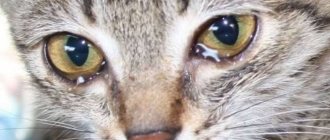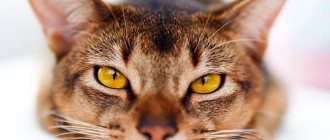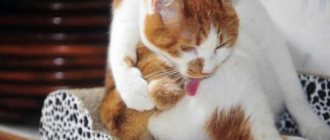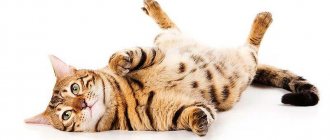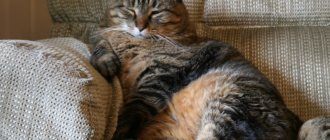The brain is the central organ in all animals. Therefore, the slightest violations in its work can lead to irreparable consequences. One of the most serious pathologies of this organ is stroke. This is an acute circulatory disorder as a result of blockage or rupture of a vessel supplying the brain. Knowing how to recognize this disease and provide first aid, you can save your pet and reduce the risk of developing severe complications.
Features of strokes in cats
Animals suffer from strokes less often than people, but the pathology can also occur in them. The risk increases especially in older pets. Young animals are more likely to develop microstrokes—a milder degree of cerebrovascular accident.
The main difference between microstrokes is the smaller area of damage to brain tissue and the duration of oxygen starvation of nerve cells. This condition is much easier to treat and is less likely to be accompanied by long-term disorders of the nervous system. But don't underestimate the seriousness of this condition. In any case, the animal will need urgent help.
How to deal with the consequences?
After such a serious illness, the cat goes through a long period of rehabilitation, which can last from six to twelve months.
The cat may experience uncertainty in movements, deterioration or loss of vision and hearing, and often memory loss.
During the rehabilitation period, it is important to give medications prescribed by a veterinarian that will support the animal’s body and help it overcome the consequences of the disease.
All this time, the owner will have to massage the cat himself or with the assistance of a massage therapist who specializes in cats.
The most favorable conditions for the complete rehabilitation of a cat after a stroke are created if the cat began to take treatment on time, and in the very first days its condition began to improve significantly.
Causes of pathology
The main factors predisposing to the development of stroke include low physical activity, excess weight and an unbalanced diet (excess fat). These factors often provoke the development of diabetes mellitus, the complication of which is often a stroke. Other diseases that can lead to disruption of the blood supply to the brain include:
- parasitic infections and helminthiasis, accompanied by an increase in body temperature;
- hypertension;
- prolonged stress and the disorders of the nervous system provoked by it;
- pathologies of the cardiovascular system (congenital or acquired);
- injuries of the skull and spine;
- oncological diseases;
- acute poisoning with poisons affecting the walls of blood vessels;
- renal failure;
- autoimmune diseases (vasculitis).
Although the causes of a stroke can vary greatly, the symptoms will almost always be the same, as will the principles of helping the animal.
Risk factors
Not so long ago, it was believed that strokes could only occur in older cats. But today's statistics show that the average age of cats with strokes is 7-9 years. And this is a mature age, not at all an old age.
Read more about the age of cats: How old is a cat by human standards?
As already mentioned, this pathology in cats does not occur very often. However, a number of factors can significantly increase the risk of cerebral circulatory disorders, which in turn can lead to a stroke. These risk factors include:
— traumatic brain injuries and spinal injuries; - diabetes; - excess weight due to a sedentary lifestyle; - frequent intoxications of the body, which damage the walls of blood vessels; - taking hormonal pills (for example, to suppress sexual desire); - the presence of parasites that live in the blood and interfere with blood flow; - severe stress.
Main symptoms of the disease
The first and earliest manifestation of a stroke is changes in the pupils. The pet's eyes begin to make frequent, involuntary fluctuations, and the pupils of the left and right eyes begin to differ in size. Other symptoms and the degree of their manifestation will depend on the extent of the circulatory disorder. Common symptoms of a stroke include:
- change in behavior (lethargy or unreasonable aggression);
- digestive system disorders (vomiting, constipation, involuntary bowel movements and urination);
- loss of consciousness for up to 2 minutes (fainting);
- gait disturbances, convulsions, paralysis;
- rapid breathing;
- hemorrhages in the eyeballs;
- severe muscle weakness, up to the inability to swallow food.
If one or more of these symptoms appears, you should immediately seek help from a veterinary center. Try to record all the problems that occur in the animal (in writing), this will facilitate the process of making a diagnosis and prescribing the correct treatment.
Manifestations of a microstroke
Such pathologies may not be accompanied by significant symptoms, so they are easy to ignore. Most often, the following symptoms indicate the presence of a microstroke:
- drowsiness, lethargy of the pet;
- vomit;
- headache. The animal meows loudly and pitifully, trying to hide in the quietest place;
- photophobia. The cat tries to hide in the darkest areas of the house;
- sudden changes in blood pressure. The cat suddenly, for no reason, freezes in place in a state of heightened attention.
It is important to pay attention to these violations in time and seek qualified help. Such symptoms can occur with many other pathologies, but only a specialist can make an accurate diagnosis.
What to do after
A caring, competent cat owner will immediately visually determine by his behavior that trouble has happened to the fluffy cat and will do the right thing:
- will not apply cold or heat to the head, so as not to aggravate the pet’s condition;
- will not independently provide pre-medical care or administer medication;
- will try to talk to the pet, will calm it down with his voice;
- carefully place the cat in a hard carrier and, as quickly as possible, try to deliver the patient to the veterinary clinic.
Diagnostics
In most cases, to make an accurate diagnosis, the veterinarian only needs to examine the furry patient and interview his owner. But in order to prescribe the correct treatment, it will be necessary to clarify the type of pathology, the degree of brain damage and a number of other important indicators. For this, additional tests are prescribed:
- laboratory analysis of blood and urine;
- magnetic resonance imaging;
- computed tomography.
These are the most effective diagnostic methods available today. They allow you to accurately identify a stroke and find out which parts of the brain it affected.
How to provide first aid to an animal
The most important thing if you suspect a stroke in a cat is to immediately contact a veterinarian and describe all the symptoms that the animal has experienced. After this, you will need to take him to a specialized veterinary clinic as quickly as possible. But there are situations when you will need to see a veterinarian at home, since the risks when transporting your pet will be too high. In this case, before the doctor arrives, the cat needs to be given first aid. It consists of:
- placing the animal on its side. Any flat and soft surface is suitable for this;
- avoiding contact of the pet with any potentially dangerous objects;
- examining the mouth, if necessary, you will need to clean it of vomit or excess saliva;
- distracting and calming the cat by stroking and quiet conversation.
It is also necessary to get rid of any possible irritants. You need to close the curtains and remove sources of loud sounds or bright lights. It is important to remember that before the veterinarian arrives, it is strictly forbidden to give the animal medications or give injections. Also, do not use cold compresses or other “home” treatment options. Their use can worsen the cat's condition, even lead to death.
Treatment methods
Stroke is a disease for which there is no single cure. To help the cat, treatment is prescribed that should smooth out and eliminate as much as possible the consequences of the blood circulation being impaired. The main goal of stroke treatment is to resolve the resulting hematoma and restore damaged blood vessels.
- To relieve inflammation of the brain, doctors use modern drugs that relieve such inflammation.
- If a four-legged patient is vomiting, he is prescribed antiemetic medications.
- Often, as part of complex therapy in the treatment of stroke, sedatives are prescribed to eliminate disorientation, anisocoria and nystagmus.
- If there is a risk of infection occurring and developing, the use of antibiotics is effective.
- Improving brain function is achieved by prescribing neuroprotectors.
- Pain syndrome is reduced by antispasmodics.
- The use of decongestant medications reduces the risk of developing cerebral edema.
- Ringer-Locke solution is administered subcutaneously every 3-4 hours after a stroke is diagnosed to avoid dehydration of the pet's body.
- To nourish the brain and maintain the animal's strength, a glucose solution is prescribed.
The owner should understand that only a doctor can prescribe the correct treatment. Under no circumstances should you self-medicate if the owner does not want to harm his pet. Only by strictly following the recommendations of a professional can positive dynamics of the course of the disease be achieved.
It is necessary that the place where the pet is located is constantly warm and dry. The bedding should be changed after each urination or defecation. If the cat cannot move on its own, it needs to be turned over every two hours, then it will not develop bedsores. The fluffy beauty should receive liquid food from a syringe if it is impossible to consume food on her own. You should also pour water into the cat from a syringe. At the same time, you need to constantly check whether the tongue is stuck.
If you follow all the doctor’s recommendations, the cat’s condition will improve within the first three days. If no positive changes occur during this time, then the most unfavorable outcomes of the disease are possible.
Drug therapy
Stroke itself cannot be cured, since it is a consequence of other pathologies. Therefore, therapy is aimed at eliminating the factors that provoked it and restoring normal blood circulation in the brain.
First of all, the animal is given infusion therapy (drips) aimed at restoring the body and preventing dehydration. After the cat’s condition has stabilized, symptomatic treatment is prescribed. It allows you to strengthen the walls of blood vessels, improve the functioning of neurons and prevent their further death. For this purpose they prescribe:
- Prednisolone. A hormonal drug that effectively eliminates swelling and inflammation.
- But-shpu. The product eliminates spasms and pain caused by them.
- Glucose. Provides additional nutrition to body cells, primarily neurons.
- Neuromidin. Helps restore impulse transmission between nerve cells.
Depending on the clinical picture, the animal may be prescribed other drugs, for example, diuretics, antibiotics or antiemetics. In case of significant oxygen starvation, oxygenation is carried out. To do this, the animal is put on a breathing mask or placed in a special chamber with a high oxygen content.
Prevention rules
How to avoid a stroke in your pet:
- Feed the animal only high-quality food.
- Periodically spend time with your cat outside. As a last resort, you can let your pet out onto the balcony.
- Keep household chemicals away from pets.
- Make sure there is always fresh water in the bowl.
- Do not overfeed your cat, especially if it is neutered.
- Give your pet anti-worm medications once every 3 months.
- Play with the animal regularly, avoiding physical inactivity. If the pet is active, then the risk of congestion is reduced several times.
- Do not engage in self-therapy if your pet has any infectious disease.
- Protect your furry friend from stress.
- Monitor blood pressure levels in cats over 9 years of age.
If your cat is at increased risk of stroke, it is important to regularly measure your cat's blood pressure.
To prevent acute ischemia, it is important to visit a veterinarian once a year for a general examination of your pet, and also monitor the cat’s behavior. If there is any alarm signal, immediately contact a specialist.
To prevent heart attack and stroke, I tried to feed my pet high-quality food. The cat never suffered from increased weight and always led an active lifestyle. To improve the condition of the body and prevent a number of diseases, she gave the pet vitamins in the form of fish, which she ate with pleasure.
Home care and treatment
It is better for the cat to spend the first few days after a stroke in a hospital. This will allow him to receive maximum medical care, since the animal will be under constant supervision of medical personnel. Once the threat to life has been eliminated, treatment can be continued at home.
During home treatment, you will need to administer drugs in the form of injections. They are:
- subcutaneous Injected using a special syringe into the withers of the animal;
- intramuscular. The injection is given into large muscles;
- intravenous. Most often, droppers are used for intravenous administration.
It is important to consider that to perform injections you must have sufficient knowledge and skills. If they are not available, it is better to entrust the injections to veterinarians. To do this, you will need to bring the animal to the clinic or call a veterinary nurse to your home.
You need to pay attention to the proper nutrition of your pet. If chewing function and the ability to swallow food are preserved, there will be no difficulties. Otherwise, you need to feed through a syringe or IV. Food should be easily digestible in liquid or semi-liquid form. Try to avoid fatty meats; a simple chicken breast is optimal. Vegetables, dairy products, and light broths will also be needed.
To place the animal, you will need to choose the quietest corner with dim lighting. A lying cat needs to be turned over every three hours, this is necessary to prevent bedsores. If the animal tries to get up and walk on its own, do not interfere, but monitor all movements.
To speed up rehabilitation, various additional techniques can be used:
- massage;
- electrophoresis;
- magnetotherapy.
The first improvements will become noticeable 1-2 weeks after the start of the course of physiotherapy. It is important to remember that full recovery after a stroke is a long process and can take from six months to one and a half years.
Rehabilitation period after a stroke
For the first 3-5 days, it is better to leave the animal in the hospital so that the entire treatment process is under the supervision of a specialist. It is important to note the slightest changes in the condition, both in the direction of improvement and deterioration, in order to promptly correct therapy.
- The cat should lie on dry, soft, warm bedding, which should be changed regularly as it becomes contaminated with urine and feces if it has uncontrollable bowel movements.
- If the animal cannot roll over on its own, it must be done independently at regular intervals to avoid bedsores.
- If paralysis is noted, then regular massage of the body and, especially the paralyzed limbs and abdomen, is necessary to improve intestinal motility.
- It is strictly forbidden for an animal to be in a draft or in a cold room - the risk of developing pneumonia increases. This is the most severe complication after a stroke, from which paralyzed cats often die due to the fact that the body does not have enough strength to fight the infection.
- With the right therapeutic approach, within the first 3 days you can tell whether the animal will recover or not. The consequences of ischemia are usually not as pronounced as in humans. Murok has well-developed compensatory and adaptive properties and many minor deviations in behavior after a stroke may not even be noticed by the owners.
- There should always be access to clean water and easily digestible liquid food. You may have to carefully spoon feed and drink from a syringe. If it is impossible to feed yourself, rehydration and nutritional drips are placed.
- It is possible that blood thinners will have to be used for life (if the animal is prone to blood clots).
- Physiotherapy is acceptable according to indications - electrophoresis, magnetic therapy, electrical stimulation.
Consequences of a stroke
The most serious complication of a stroke is the death of a pet. Other severe and practically irreparable consequences include:
- Complete or partial paralysis. It is difficult to treat and persists throughout life in most animals.
- Pneumonia. Occurs as a result of inhalation of vomit or prolonged lying down. With proper care and treatment, it does not occur at all or heals quickly enough.
- Visual and hearing impairments. In most cases they are reversible.
Some complications can be treated, but there are often situations where they remain with the animal for life. But with proper and timely treatment, the likelihood of irreversible consequences will be much less.
Life expectancy and relapses
The prognosis for ischemic stroke is most favorable. Hemorrhagic forms are severe and often result in the death or severe disability of the cat. The sooner qualified assistance was provided, the better the prognosis; this is one of the main factors in the full restoration of brain function after a stroke.
As a rule, relapses occur in the absence of treatment for the underlying disease that caused the stroke. Therefore, strict adherence to medical recommendations will reduce their likelihood to a minimum.
Diagnostic measures for diagnosing stroke in a veterinary clinic
Making an accurate diagnosis is facilitated by a number of tests:
- General and clinical analysis of urine and blood, which can indicate a possible pathology;
- Ultrasound of the abdominal cavity to identify gastrointestinal pathologies;
- X-rays of the lungs to exclude possible tumors and damage;
- MRI to determine abnormal blood flow in the brain;
- Electroencephalograms to detect disruptions in brain function
Moreover, in some cases, if Cushing's syndrome is suspected, the doctor may prescribe a cerebrospinal fluid analysis. Prompt collection of data and timely treatment can save the life of your beloved pet.
Therefore, it is worth completely excluding independent intervention in restoring the pet’s health at the slightest suspicion of a stroke in cats; treatment should be prescribed by a qualified veterinarian with an individual selection of drugs according to the symptoms and collected tests.
The only way a cat owner can help is to consult a doctor in time and follow all recommendations for the rehabilitation of the pet.
How to prevent a stroke
There is no specific prevention of this pathology, but steps can be taken to reduce the likelihood of developing a stroke. The most effective include:
- Careful monitoring of body weight. Even if the norm is slightly exceeded, it is necessary to adjust the diet and stimulate the pet’s physical activity;
- balanced diet. It should consist of at least half protein, try to avoid excess fat;
- Monitor blood pressure, especially in older animals. For this, a special tonometer is used;
- Avoid exposing your pet to severe stress;
- secure the space available to the cat. It is necessary to store hazardous substances in places inaccessible to the animal; a good solution would be to install a special mesh on the window to prevent it from falling;
- Make sure your pet gets enough fresh air and physical activity.
Stroke is an extremely serious pathology, the development of which is much easier and cheaper to prevent than to treat. Therefore, try to pay maximum attention to prevention, this will reduce the likelihood of developing a stroke and its severe complications.
